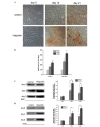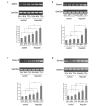Hepcidin promotes osteogenic differentiation through the bone morphogenetic protein 2/small mothers against decapentaplegic and mitogen-activated protein kinase/P38 signaling pathways in mesenchymal stem cells
- PMID: 25351366
- PMCID: PMC4237087
- DOI: 10.3892/mmr.2014.2769
Hepcidin promotes osteogenic differentiation through the bone morphogenetic protein 2/small mothers against decapentaplegic and mitogen-activated protein kinase/P38 signaling pathways in mesenchymal stem cells
Abstract
The ability of mesenchymal stem cells (MSCs) to differentiate into osteogenic lineages requires management for their future use in treating bone destruction and osteoporosis. Hepcidin is closely associated with bone metabolism, however, it remains to be elucidated whether hepcidin affects osteogenic differentiation in MSCs. The present study demonstrated that hepcidin enhanced osteoblastic differentiation and mineralization, which was manifested by an upregulation in the differentiation markers alkaline phosphatase and osteogenic genes. Furthermore, the expression levels of bone morphogenetic proteins and small mothers against decapentaplegic homologs were concomitantly increased following hepcidin treatment. In addition, the p38 mitogen-activated protein kinase may be an upstream kinase for osteoblastic differentiation. Thus, hepcidin may be important in the osteogenic differentiation of MSCs and may be considered as a target in the development of therapies for pathological bone loss.
Figures




Similar articles
-
Effect of TAK1 on osteogenic differentiation of mesenchymal stem cells by regulating BMP-2 via Wnt/β-catenin and MAPK pathway.Organogenesis. 2018 Jan 2;14(1):36-45. doi: 10.1080/15476278.2018.1455010. Organogenesis. 2018. PMID: 29913119 Free PMC article.
-
Age-Related Insulin-Like Growth Factor Binding Protein-4 Overexpression Inhibits Osteogenic Differentiation of Rat Mesenchymal Stem Cells.Cell Physiol Biochem. 2017;42(2):640-650. doi: 10.1159/000477873. Epub 2017 Jun 9. Cell Physiol Biochem. 2017. PMID: 28595186
-
Fish bone peptide promotes osteogenic differentiation of MC3T3-E1 pre-osteoblasts through upregulation of MAPKs and Smad pathways activated BMP-2 receptor.Cell Biochem Funct. 2018 Apr;36(3):137-146. doi: 10.1002/cbf.3325. Epub 2018 Feb 1. Cell Biochem Funct. 2018. PMID: 29392739
-
The effect of five proteins on stem cells used for osteoblast differentiation and proliferation: a current review of the literature.Cell Mol Life Sci. 2014 Jan;71(1):113-42. doi: 10.1007/s00018-013-1326-0. Epub 2013 Apr 9. Cell Mol Life Sci. 2014. PMID: 23568025 Free PMC article. Review.
-
Natural Compounds for Bone Remodeling: Targeting osteoblasts and relevant signaling pathways.Biomed Pharmacother. 2024 Nov;180:117490. doi: 10.1016/j.biopha.2024.117490. Epub 2024 Sep 26. Biomed Pharmacother. 2024. PMID: 39332184 Review.
Cited by
-
Ferroptosis: Regulatory mechanisms and potential targets for bone metabolism: A review.Medicine (Baltimore). 2024 Sep 27;103(39):e39158. doi: 10.1097/MD.0000000000039158. Medicine (Baltimore). 2024. PMID: 39331895 Free PMC article. Review.
-
New highlight in breast cancer development: the key role of hepcidin and iron metabolism.Ann Transl Med. 2018 Nov;6(Suppl 1):S56. doi: 10.21037/atm.2018.10.30. Ann Transl Med. 2018. PMID: 30613631 Free PMC article. No abstract available.
-
Transplantation of Neural Precursors Derived from Induced Pluripotent Cells Preserve Perineuronal Nets and Stimulate Neural Plasticity in ALS Rats.Int J Mol Sci. 2020 Dec 16;21(24):9593. doi: 10.3390/ijms21249593. Int J Mol Sci. 2020. PMID: 33339362 Free PMC article.
-
Noncoding RNAs: the crucial role of programmed cell death in osteoporosis.Front Cell Dev Biol. 2024 May 10;12:1409662. doi: 10.3389/fcell.2024.1409662. eCollection 2024. Front Cell Dev Biol. 2024. PMID: 38799506 Free PMC article. Review.
-
Iron accumulation and its impact on osteoporotic fractures in postmenopausal women.J Zhejiang Univ Sci B. 2023 Apr 15;24(4):301-311. doi: 10.1631/jzus.B2200519. J Zhejiang Univ Sci B. 2023. PMID: 37056206 Free PMC article. Review.
References
-
- Kanis JA, Reginster JY. European guidance for the diagnosis and management of osteoporosis in postmenopausal women - what is the current message for clinical practice? Pol Arch Med Wewn. 2008;118:538–540. - PubMed
-
- de Lignieres B. Hormone replacement therapy: clinical benefits and side-effects. Maturitas. 1996;23:S31–S36. - PubMed
-
- Fournier A, Berrino F, Riboli E, Avenel V, Clavel-Chapelon F. Breast cancer risk in relation to different types of hormone replacement therapy in the E3N-EPIC cohort. Int J Cancer. 2005;114:448–454. - PubMed
Publication types
MeSH terms
Substances
LinkOut - more resources
Full Text Sources
Other Literature Sources

